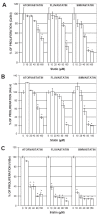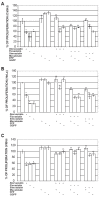Statins inhibit the proliferation and induce cell death of human papilloma virus positive and negative cervical cancer cells
- PMID: 23675166
- PMCID: PMC3614803
Statins inhibit the proliferation and induce cell death of human papilloma virus positive and negative cervical cancer cells
Abstract
Statins, competitive inhibitors of 3-hydroxy-3-methylglutaryl-coenzyme A (HMG-CoA) reductase, have anti-tumoral effects on multiple cancer types; however, little is known about their effect on cervical cancer. We evaluated the effect on proliferation, cell cycle, oxidative stress and cell death of three statins on CaSki, HeLa (HPV(+)) and ViBo (HPV(-)) cervical cancer cell lines. Cell proliferation was assayed by crystal violet staining, cell cycle by flow cytometry and cell death by annexin-V staining. Reactive oxygen species (ROS) production was evaluated by the oxidation of 2,7-dichlorofluorescein diacetate and nitrite concentration (an indirect measure of nitric oxide (NO) production), by the Griess reaction. Inhibition of cell proliferation by atorvastatin, fluvastatin and simvastatin was dose-dependent. ViBo cells were the most responsive. Statins did not affect the cell cycle, instead they induced cell death. The antiproliferative effect in ViBo cells was completely inhibited with mevalonate, farnesyl pyrophosphate (FPP) and geranylgeranyl pyrophosphate (GGPP) treatments. In contrast, cell proliferation of CaSki and HeLa cells was partially (33%) rescued with these intermediates. The three statins increased ROS and nitrite production, mainly in the ViBo cell line. These results suggest that statins exert anti-tumoral effects on cervical cancer through inhibition of cell proliferation and induction of cell death and oxidative stress. Statins could be an aid in the treatment of cervical cancer, especially in HPV(-) tumors.
Keywords: cell cycle; cell death; cervical cancer; human papilloma virus; mevalonate pathway; oxidative stress; proliferation; statins.
Figures





Similar articles
-
HMG-CoA reductase inhibitors induce apoptosis of lymphoma cells by promoting ROS generation and regulating Akt, Erk and p38 signals via suppression of mevalonate pathway.Cell Death Dis. 2013 Feb 28;4(2):e518. doi: 10.1038/cddis.2013.44. Cell Death Dis. 2013. PMID: 23449454 Free PMC article.
-
Statins inhibit blastocyst formation by preventing geranylgeranylation.Mol Hum Reprod. 2016 May;22(5):350-63. doi: 10.1093/molehr/gaw011. Epub 2016 Feb 7. Mol Hum Reprod. 2016. PMID: 26908642 Free PMC article.
-
Isoprenoids responsible for protein prenylation modulate the biological effects of statins on pancreatic cancer cells.Lipids Health Dis. 2017 Dec 20;16(1):250. doi: 10.1186/s12944-017-0641-0. Lipids Health Dis. 2017. PMID: 29262834 Free PMC article.
-
Antileukemic properties of 3-hydroxy-3-methylglutaryl-coenzyme A reductase inhibitors.Leuk Lymphoma. 2013 Dec;54(12):2601-5. doi: 10.3109/10428194.2013.790022. Epub 2013 Jul 29. Leuk Lymphoma. 2013. PMID: 23540342 Review.
-
Studies of the isoprenoid-mediated inhibition of mevalonate synthesis applied to cancer chemotherapy and chemoprevention.Exp Biol Med (Maywood). 2004 Jul;229(7):567-85. doi: 10.1177/153537020422900701. Exp Biol Med (Maywood). 2004. PMID: 15229351 Review.
Cited by
-
Statin Use and Cancer Incidence in Patients with Type 2 Diabetes Mellitus: A Network Meta-Analysis.Gastroenterol Res Pract. 2018 Sep 4;2018:8620682. doi: 10.1155/2018/8620682. eCollection 2018. Gastroenterol Res Pract. 2018. PMID: 30254671 Free PMC article. Review.
-
Simvastatin treatment varies the radiation response of human breast cells in 2D or 3D culture.Invest New Drugs. 2021 Jun;39(3):658-669. doi: 10.1007/s10637-020-01046-6. Epub 2020 Dec 11. Invest New Drugs. 2021. PMID: 33313978 Free PMC article.
-
Investigating potential anti-proliferative activity of different statins against five cancer cell lines.Saudi Pharm J. 2023 May;31(5):727-735. doi: 10.1016/j.jsps.2023.03.013. Epub 2023 Mar 24. Saudi Pharm J. 2023. PMID: 37181137 Free PMC article.
-
Atorvastatin differentially regulates the interactions of cocaine and amphetamine with dopamine transporters.Neuropharmacology. 2023 Mar 1;225:109387. doi: 10.1016/j.neuropharm.2022.109387. Epub 2022 Dec 23. Neuropharmacology. 2023. PMID: 36567004 Free PMC article.
-
The effect and mechanism of atorvastatin regulating PI3K-Akt-mTOR pathway on radiosensitivity of hepatocellular carcinoma cells.Toxicol Res (Camb). 2025 Feb 25;14(1):tfae202. doi: 10.1093/toxres/tfae202. eCollection 2025 Feb. Toxicol Res (Camb). 2025. PMID: 40012843
References
-
- Jakobisiak M, Golab J. Potential antitumor effects of statins. Int. J. Oncol. 2003;23:1055. - PubMed
-
- Goldstein JL, Brown MS. Regulation of the mevalonate pathway. Nature. 1990;343:425. - PubMed
-
- Alegret M, Silvestre JS. Pleiotropic effects of statins and related pharmacological experimental approaches. Methods Find Exp. Clin. Pharmacol. 2006;28:627. - PubMed
-
- Graaf MR, Richel DJ, van Noorden CJ, GucHeLaar HJ. Effects of statins and farnesyltransferase inhibitors on the development and progression of cancer. Cancer Treat. Rev. 2004;30:609. - PubMed
-
- Dimitroulakos J, Ye LY, Benzaquen M, Moore MJ, et al. Differential sensitivity of various pediatric cancers and squamous cell carcinomas to lovastatin-induced apoptosis: therapeutic implications. Clin. Cancer Res. 2001;7:158. - PubMed
LinkOut - more resources
Full Text Sources
